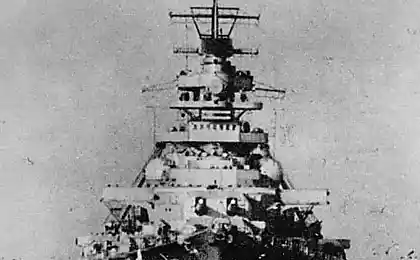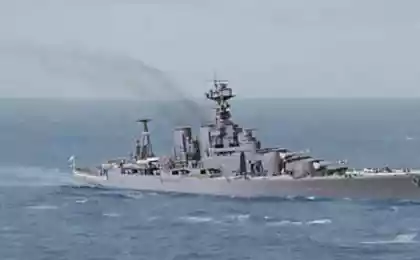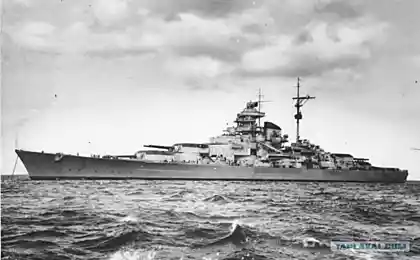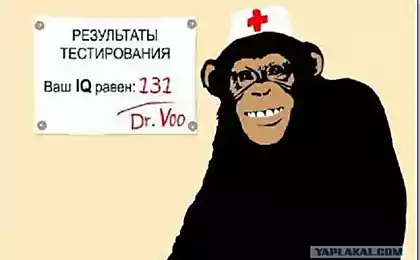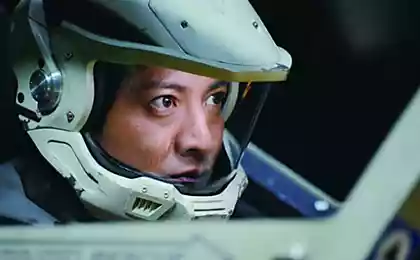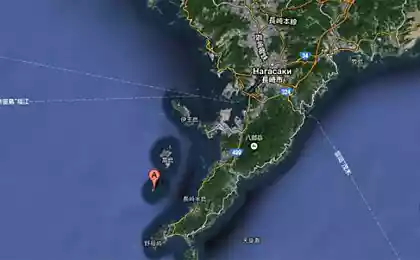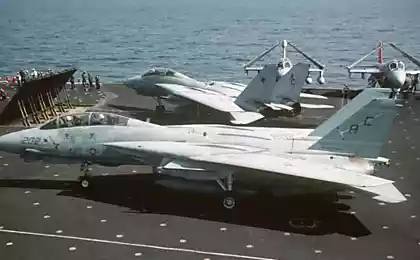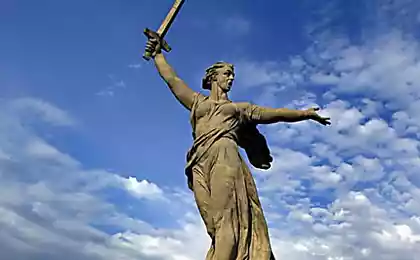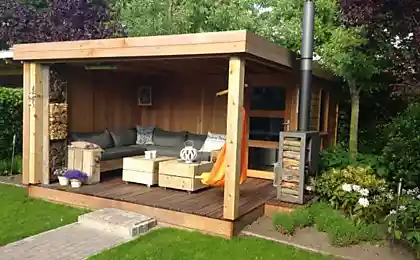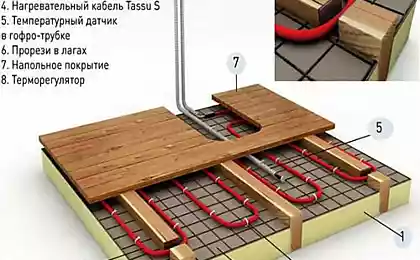814
Concrete Battleship (11 photos)
Fort is located on the island of El Fraulein fairway near the southern entrance to Manila Bay, Luzon, Philippines. More precisely, "the fort on the island" - it is said is not entirely accurate. Rather, the island is under the fort. Build a fort began in 1909, the name was given at the same time - in honor of Brigadier Richard genarala Drama, the hero of the US-Mexican and the American Civil War, also known that drove notably at the time the Sioux Indians. On the issue of building approached simply and directly - take this very island of El Fraulein, he cut down the tip, trim the contours required under, top poured concrete fortifications, and in the resulting cake prodolbili interior. Here in the photo - the island of El Frehley before construction.


Armament was quite powerful - four chetyrnadtsatidyuymovye (356 mm) guns in two revolving towers and four six-inch (152 mm) - two dungeons in the walls. Later, when he showed his sharp teeth aviation, anti-aircraft weapons fort complement of two 76-mm cannon and two machine guns (although installed anti-aircraft weaponry was discovered - on the deck of the fort, without any protection). In the photo below - the tower of the main fire on ground tests.

In 1918 the fort officially put into operation. From the Navy, he quickly earned the nickname «concrete battleship» («concrete battleship"), under which, and went down in history - first, because of the shape, and secondly, due to the fact that the positions of observation and adjustment of artillery fire were placed on the lattice tower, is very similar to the mast of the then American warships. In addition to the gun turrets on the deck one can see the wooden buildings - barracks and warehouses. They assume as temporary until they are completed yet appropriate interior, but, as we know, there is nothing more permanent than temporary - even when the garrison and supplies moved under the protection of concrete floors, makeshift left. Extra usable space, as we know, does not happen.

Longitudinal section of the fort. Protection of the fort has been very strong - the walls ranged in thickness from seven to eleven and a half meters, and the top floor ("deck") were six meters thick. In addition, it was at that time ednstvenny American fort, the main gauge is placed in armored towers. Inside the fort there are four floors and was completely self-contained - a garrison of two hundred and fifty men could fight in total isolation from the outside world for several months.

View from the mast of the tower of the main fire.

Fort had notably to war. From December 1941 to May 1942 he took part in the defense of the Philippines from the Japanese invasion. Chetyrnadtsatidyuymovki have proven excellent - everything that gets in their range (which is about twenty kilometers) immediately ground into porridge. The Japanese suffered heavy losses from the fire of the fort, but to do anything with it could not - they, unlike the Germans, ofigennokalibernyh concrete-bombs for the destruction of permanent fortifications was not, and all that is of smaller caliber, "concrete battleship" was like an elephant's grain. By the way, all of these almost six months of the fort fought on full self-sufficiency, not having received from the mainland or crackers - as expected pre-war plans. Generally, all sides showed themselves remarkably. However, one of the fort, though awesome, was not enough, and the Japanese still won. The garrison left the fort goodbye blowing up everything that could explode. The Japanese got useless, in fact, a piece of concrete in the middle of the ocean. Repair it, they did not try, but, nevertheless, for some reason, put a garrison there. In April, forty-five, when the Americans recaptured the Philippines back to them this very garrison discovered with some surprise. In the photo below - landing craft LSM-51 is coming to the fort (on the left, you can see its not so good on the background of the wall). By the way, you can estimate the number of shell dents on the walls - fired Drum notably.

Marines landed on the deck of the fort.

To negotiate the surrender of the Americans did not deem it necessary, arrange fraught with heavy losses sweep the tunnels - also, so that void sumnyashesya, poured into the ventilation Fort fourteen thousand liters of petrol mixture (two parts oil to one part gasoline), put vryvatel ten minutes and clamped ears stronger. The Japanese lost everything, the fort came into a state of complete and total non-repairable.

The ruins of Fort Drum in 1983. In the background - the battleship "New Jersey».
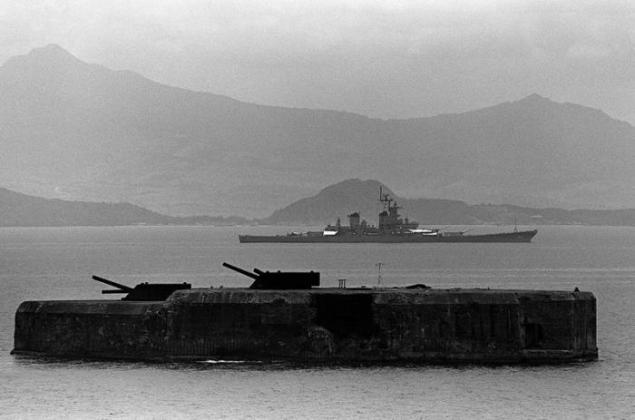
The ruins of a bird's-eye view. Now the fort carry tourists also make pilgrimages to fans of military history and all abandoned.
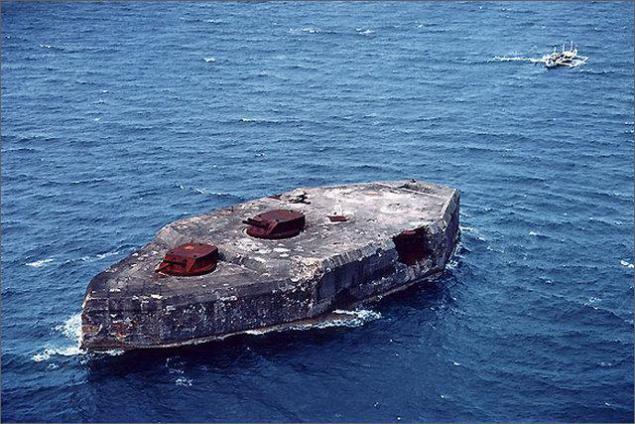


Armament was quite powerful - four chetyrnadtsatidyuymovye (356 mm) guns in two revolving towers and four six-inch (152 mm) - two dungeons in the walls. Later, when he showed his sharp teeth aviation, anti-aircraft weapons fort complement of two 76-mm cannon and two machine guns (although installed anti-aircraft weaponry was discovered - on the deck of the fort, without any protection). In the photo below - the tower of the main fire on ground tests.

In 1918 the fort officially put into operation. From the Navy, he quickly earned the nickname «concrete battleship» («concrete battleship"), under which, and went down in history - first, because of the shape, and secondly, due to the fact that the positions of observation and adjustment of artillery fire were placed on the lattice tower, is very similar to the mast of the then American warships. In addition to the gun turrets on the deck one can see the wooden buildings - barracks and warehouses. They assume as temporary until they are completed yet appropriate interior, but, as we know, there is nothing more permanent than temporary - even when the garrison and supplies moved under the protection of concrete floors, makeshift left. Extra usable space, as we know, does not happen.

Longitudinal section of the fort. Protection of the fort has been very strong - the walls ranged in thickness from seven to eleven and a half meters, and the top floor ("deck") were six meters thick. In addition, it was at that time ednstvenny American fort, the main gauge is placed in armored towers. Inside the fort there are four floors and was completely self-contained - a garrison of two hundred and fifty men could fight in total isolation from the outside world for several months.

View from the mast of the tower of the main fire.

Fort had notably to war. From December 1941 to May 1942 he took part in the defense of the Philippines from the Japanese invasion. Chetyrnadtsatidyuymovki have proven excellent - everything that gets in their range (which is about twenty kilometers) immediately ground into porridge. The Japanese suffered heavy losses from the fire of the fort, but to do anything with it could not - they, unlike the Germans, ofigennokalibernyh concrete-bombs for the destruction of permanent fortifications was not, and all that is of smaller caliber, "concrete battleship" was like an elephant's grain. By the way, all of these almost six months of the fort fought on full self-sufficiency, not having received from the mainland or crackers - as expected pre-war plans. Generally, all sides showed themselves remarkably. However, one of the fort, though awesome, was not enough, and the Japanese still won. The garrison left the fort goodbye blowing up everything that could explode. The Japanese got useless, in fact, a piece of concrete in the middle of the ocean. Repair it, they did not try, but, nevertheless, for some reason, put a garrison there. In April, forty-five, when the Americans recaptured the Philippines back to them this very garrison discovered with some surprise. In the photo below - landing craft LSM-51 is coming to the fort (on the left, you can see its not so good on the background of the wall). By the way, you can estimate the number of shell dents on the walls - fired Drum notably.

Marines landed on the deck of the fort.

To negotiate the surrender of the Americans did not deem it necessary, arrange fraught with heavy losses sweep the tunnels - also, so that void sumnyashesya, poured into the ventilation Fort fourteen thousand liters of petrol mixture (two parts oil to one part gasoline), put vryvatel ten minutes and clamped ears stronger. The Japanese lost everything, the fort came into a state of complete and total non-repairable.

The ruins of Fort Drum in 1983. In the background - the battleship "New Jersey».

The ruins of a bird's-eye view. Now the fort carry tourists also make pilgrimages to fans of military history and all abandoned.

